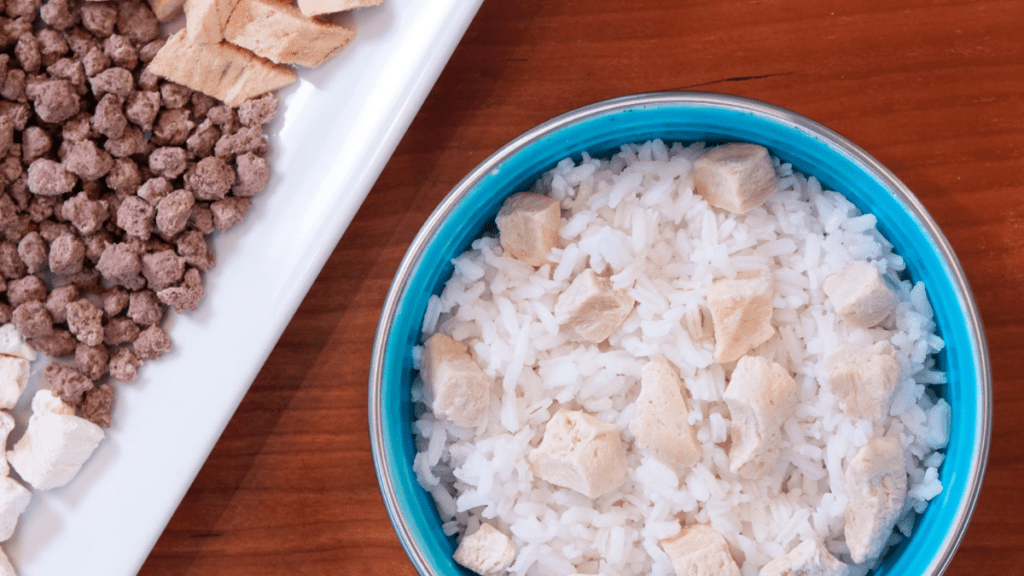Obviously, call your veterinary clinic. They will help you assess whether or not this bout of diarrhea is urgent, or if you can manage it with some home treatments. We can pretty much guarantee, though, that one of the recommendations you’ll hear is to put your pooch on a bland diet until her stools are back to normal. This article explains how to whip up a bland diet, so that you can be one step ahead when you call your vet.
Bland Diets for Dogs
When cooking the protein, the goal is for it to be as lean as possible, because fat can upset the gastrointestinal tract even more. Any ground meat should be lean and boiled. Make sure to rinse the meat after you’ve drained it. If you prefer to pan fry the ground meat, just make sure to rinse all the fat off with hot water. Don’t add any seasonings or cooking fats (eg. butter or olive oil).
The carbohydrate should be prepared by boiling it without any added seasonings or oils. If your pup turns their nose up at the “blah” meal you’ve laid out for them, you can try adding some flavor with some low-sodium chicken, vegetable or beef broth. Some dogs will prefer the texture of a bland diet when it’s been watered down a bit.
Let both the meat and the carbohydrate cool off before you serve it to your dog. Combine the carb and meat in a 3:1 ratio (75% of the mixture should be carbohydrate and 25% should be protein). Begin by offering a small amount (1-2 teaspoons for a small dog, 1-2 tablespoons for a medium/large dog) of the mixture every two to three hours. If your pup is tolerating the bland diet well, you can gradually increase the amount that you feed each meal, and reduce the frequency of feedings in a day. In general, a dog can have one cup of a bland diet mixture per 10 pounds of body weight per day.
As your dog recovers from dietary indiscretion, you may want to continue to feed the bland diet for another two to three days, or until their stools are 100% normal and healthy-looking. It’s best to not go right from bland diet to their regular kibble; instead, gradually transition them back to their normal food over the course of a few days.
While your pooch may LOVE that you are cooking special meals for them, remember that this is a short term intervention. A bland diet is designed to soothe your dog’s GI tract and give it time to calm down. Bland diets are not nutritionally complete and therefore are not meant for long-term feeding.
*If you just aren’t in the mood to cook for your dog (heck, we can barely manage to whip up our own dinner some nights!) ask your vet about a prescription GI kibble or canned food. These diets are amazing at clearing up GI upset, and your vet probably has some on-hand!
Bland Diets for Cats
If your kitty is experiencing some GI distress, put away the rice and canned chicken. The best way to manage loose stools with cats is to use a prescription GI diet. These diets are specifically formulated to provide relief from digestive upset, and are usually very palatable. Your veterinarian most likely has one (if not more) options on-hand that she could prescribe and dispense for your poor kitty.
If you’d rather not go the prescription route, you could try baby food. That’s right, canned baby food from the grocery store is a pretty darn good substitute for a bland diet. We recommend a meat-based version, so that your cat is getting some protein, but make sure there aren’t any seasonings added (like onion or herbs). You can also try canned chicken or turkey meats, either on their own or mixed with some baby food.
If your cat just doesn’t have an appetite, we do have a few tricks up our sleeve. One great option for the seafood-loving cats out there is to add some tuna juice to the bland diet. Low-sodium chicken or beef broth is a good substitute if you don’t have any canned tuna on hand.
When you put your cat on a bland diet, start out by offering just a couple teaspoons at a time in more frequent feedings. If your cat is able to tolerate the new food, you can gradually increase the amount you offer and decrease the number of meals per day. Your cat’s digestive tract should recover after a few days, and when it does you should transition back to the normal diet.
Pet Probiotics
At House Paws, we are huge fans of probiotics. Gut health plays such an important role in overall wellness, and we recommend probiotics for a number of health concerns (in fact, any pet can benefit from a daily probiotic, regardless of their age or health condition). Diarrhea is a sign of GI distress, and probiotics can help to balance out the digestive tract and provide quicker relief from symptoms. Many pet owners ask if they can give their pet their own human-version of a probiotic. Dog and cat gastrointestinal systems are much different the human GI system, and human probiotics are not beneficial for pets. If you’re going to put your dog or cat on a probiotic, you’ll need to find one that is high-quality and formulated specifically for pets. Most pet probiotics come in the form of sprinkle capsules. You simply twist open the capsule and sprinkle the contents on your pet’s food. We recommend three different types of probiotics and carry all three in our office.
Diarrhea can raise panic in a household, especially in situations when a pet can’t make it outside or to the litter box in time. Switching your pet to a bland diet is the first step towards rebalancing your pet’s GI system and providing them with some relief. Your veterinary clinic will be able to provide you with some other recommendations to manage your pet’s loose stools, but a bland diet should always be part of the recommended treatment plan. A dietary change is a simple, cost-effective and non-invasive option to help firm up your pet’s stool, and the necessary items can be tucked away in the pantry or freezer so that you’re ready to go when your pet develops an upset tummy.






